Mostly praised for its features and functionality, the new Smith & Wesson M&P may be notable for something even more important: a manufacturer's willingness to listen to the end users of its product.
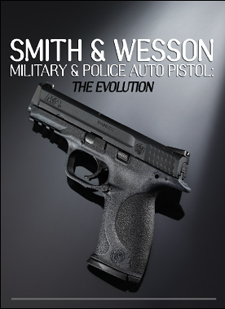
Officially introduced at the SHOT Show in Las Vegas in first quarter of 2006, the Smith & Wesson Military & Police semiautomatic service pistol became widely accepted in law enforcement, combat pistol competition, and the armed citizen sector in less than a year. Articles in the firearms and law enforcement press, and on the Internet, have concentrated on its mechanical features and its “shootability,” both of which have much to recommend them.
However, there is another story hidden within. It is the story of a rapidly changing old-line company that has found within itself the courage to break not just one mold, but two. Smith & Wesson found the courage to step past its old products and develop something dramatically new. The firm also found the courage to take a new approach to handling consumer complaints and responding to end-user needs.
Background: the Smith & Wesson M&P Pistol
Joe Bergeron, head of autoloading pistol production at S&W, led the development of the M&P pistol. Something of a child prodigy as a young engineer at Colt’s, Bergeron came to Smith & Wesson with a deep understanding of how semiautomatic pistols work, and of how they are designed, and of how they are manufactured. These are three different things entirely, and they made Bergeron a triple threat in the industry, and the logical man to spearhead the M&P project.
Bergeron and his people came up with a new design that didn’t look derivative. It was the first time Smith & Wesson had done so with a semiautomatic service pistol design in 50 or more years. This is not to say that it didn’t incorporate features from other designs. However, those features were add-ons, not whole design concepts that defined the pistol.
From Heckler and Koch came three concepts, two now almost universally adopted and the third worthy of the same acceptance. The polymer frame, first seen in the 1970s on the HK P9S and that company’s semiautomatic adaptation of its machine pistol, the VP70Z, has now become the new standard platform for police duty sidearms.
 Another now-ubiquitous feature is the attachment rail molded into the frame’s dust cover. Appearing first in the early 1990s on HK’s USP, it was originally proprietary to HK’s own UTL (Universal Tactical Light, built for them by InSight in New Hampshire), but this feature was soon standardized into a Picatinny rail format by the industry.
Another now-ubiquitous feature is the attachment rail molded into the frame’s dust cover. Appearing first in the early 1990s on HK’s USP, it was originally proprietary to HK’s own UTL (Universal Tactical Light, built for them by InSight in New Hampshire), but this feature was soon standardized into a Picatinny rail format by the industry.
Even later incarnations of HK service pistols now use the Pic rail specifications. The third feature was the ambidextrous slide release, first seen on major brand service pistols in HK’s 2000 line.
From Glock, which picked up the polymer-frame ball that HK dropped, ran with it, and popularized it, came the multi-part trigger incorporating a safety device. On the Smith the trigger differs from the original Glock in execution, however.
From Walther came the widely copied concept of interchangeable backstraps to adjust grip frame size to fit a broad variety of hand sizes.
Smith & Wesson had a tool in its toolbox that the competitors did not: an extensive, scientific study of hand size done in the early 1990s for their Sigma project. With this, plus updated knowledge of ergonomics gleaned from the rapid advance of that science as applied to pistols in the last decade, S&W’s M&P team leaped ahead of the competition with a series of grip inserts that offered not only different trigger reach, but alternate sizes and shapes of grip width to more appropriately fill the shooter’s palm. The result is probably state-of-the-art in the interchangeable auto pistol backstrap today.
No SmIG, Smock, or Smalther
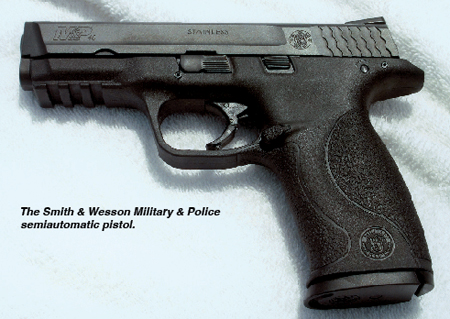 The M&P ends a long history (and, for S&W fans, a somewhat sad one) of derivative firearms design. Let’s go back about twenty years…
The M&P ends a long history (and, for S&W fans, a somewhat sad one) of derivative firearms design. Let’s go back about twenty years…
In the late 1980s, under then-CEO Steve Melvin, Smith & Wesson inaugurated its AIP (Automatic Improvement Program). The result was that its standard double-action service autos, dating back to the Model 39 of 1954, were updated into a third generation that appeared in 1988. Mechanical defects in the originals had been pretty much cleared up in the second-generation guns of the late 1970s and early 1980s, which bore three-digit model numbers (Model 459, Model 645, etc.).
The big changes in the third generation were ergonomic. Trigger pulls were smoothed out considerably, and grip profile was changed completely, causing these four-digit model number pistols (Model 5906, Model 4506, etc.) to bear a remarkable resemblance to the popular SIG- Sauer. Perhaps inevitably, these Gen Three Smiths were nicknamed “SmIGs” by the cognoscenti.
1993 saw the debut of the Sigma, S&W’s answer to the market-dominating Glock. It was like a Glock in its shape, construction, and takedown, and in .40 S&W caliber, there was even one-way interchangeability of barrels between the brands. Glock sued Smith and won a substantial settlement.
The Sigma did not take hold in the law enforcement market, though it would become a bestseller when S&W cut the price and reinvented it as an entry-level auto pistol for the armed citizen market. By then, gun buffs were derisively calling the Sigma a “Smock.”
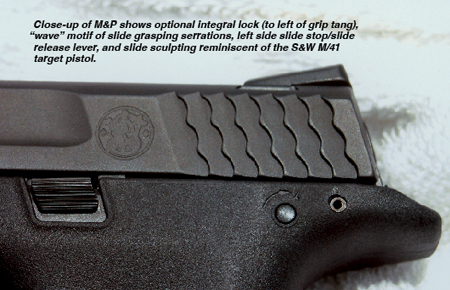 As the end of the century approached, S&W entered what would be an ever-tightening relationship with Walther. The collaboration led to an “Americanized” version of the German Walther P99, dubbed the SW99.
As the end of the century approached, S&W entered what would be an ever-tightening relationship with Walther. The collaboration led to an “Americanized” version of the German Walther P99, dubbed the SW99.
It got off to a rocky start when, in a highly publicized move, the New Jersey State Police adopted the SW99 in 9mm, and then cancelled the contract due to claims of repeated malfunctions. Some of this gun’s European design features did not work well with American law enforcement handgun doctrine.
The decocker, a push button flush-fitted on the upper left portion of the slide, was extremely awkward to operate, and the gun could be holstered cocked without that condition being visible to officer, instructor, or supervisor. These features did not endear the SW99 to the U.S. law enforcement establishment, and it too languished in the wake of ever-increasing Glock dominance of the American police market. Meanwhile, predictably, the SW99 had become known as the “Smalther.”
By contrast, no such cute nickname has attached itself to the S&W M&P, nor is that likely to happen. It does not resemble any other popular gun. Its “sculpturing” is distinctly Smith & Wesson, with slide lines that hearken back to the S&W Model 41 target pistol of the late 1950s. Grasping grooves on the slide are cut in a distinctive wavy format popularized by Smith & Wesson’s Performance Center several years before. The grip tang sweeps backward in a sleek and functional style reminiscent of nothing so much as a Robar grip re-shaping on a Glock. The Military & Police has its own design, and it has its own look.
Imperfection and Correction
No new design ever survives its “beta testing” in the field without unexpected glitches cropping up. The first guns that get into the field are the ones that endure rough currents on the final “shakedown cruise” before the product sets sail on the turbulent seas of a competitive marketplace.
Let’s take a quick look at handgun history. The Colt of 1911 did not come under scrutiny for design improvement needs until the early 1920s, and the recommendations of the Army Ordnance Board did not go into effect, creating the 1911A1 pistol, until the latter part of that decade. Making this classic gun “drop-safe” took much longer still. The 1911 design continues to evolve.
In Smith & Wesson’s own yard, the imperfections in the basic Model 39 design lay dormant from its introduction in 1954 until 1967, when the Illinois State Police became the first large police department to adopt the gun en masse. With some 1,700 troopers qualifying with them regularly and carrying them in the field, problems with extraction, feeding, and breakage now immediately became apparent.
Design changes were implemented rather quickly in the 39-2 series, but some core problems were not substantively addressed until the second-generation guns emerged more than a decade later. It took most of another decade for the refinements of the third-generation guns to at last fulfill the promise of the original S&W service automatics. The process had taken some thirty plus years.
And therein lies a tale, perhaps the most interesting part of the short S&W M&P auto pistol saga. Within less than a year, Smith & Wesson has identified shortcomings in the M&P design, and has moved immediately and substantively to correct them. This backstory is one of the most encouraging selling points of the M&P, yet has gone virtually unnoticed.
The Backstory
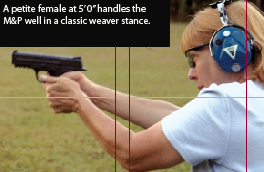 From the early stages of the M&P project, Bergeron had sought end-user input. Gun-wise cops and police instructors such as Dave Spaulding were flown to the Springfield, Massachusetts plant and solicited for input as they worked with the prototypes. Bergeron listened, and implemented recommendations.
From the early stages of the M&P project, Bergeron had sought end-user input. Gun-wise cops and police instructors such as Dave Spaulding were flown to the Springfield, Massachusetts plant and solicited for input as they worked with the prototypes. Bergeron listened, and implemented recommendations.
Example One: The Iowa State Patrol, looking to trade in their tired S&W 4046 pistols, wanted a more modern polymer handgun firing the same .40 S&W round. They acquired three test samples of the M&P. One suffered repeated feed failures.
The matter was reported to Bergeron, who set about tweaking the design. The problem was cured. ISP adopted the .40 M&P and is in the process of phasing them onto the street at this writing. The author has heard of no such feed problems with M&Ps since.
Example Two: Aware that a straight-thumbs grasp of the duty pistol had made the jump from IPSC competition into law enforcement training, and likewise aware that with some pistols (such as the Beretta and the SIG-Sauer) this grasp over-rode and deactivated the slide stop, Bergeron and his crew originally designed the ambi slide stops of the M&P in a low-profile configuration which, to boot, was shielded by a small outcropping of polymer.
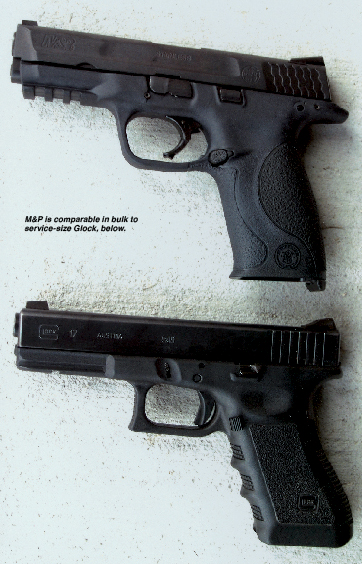 Unfortunately, the part had now become so small and deeply hidden that it was no longer accessible to a thumb that was trying to use it to close the slide.
Unfortunately, the part had now become so small and deeply hidden that it was no longer accessible to a thumb that was trying to use it to close the slide.
This writer and others noticed it immediately and brought it to Bergeron’s attention. This was one of the first “fixes” to be incorporated into the ongoing design. By summer of 2006, M&Ps were coming through with fully functional ambidextrous slide stop/slide release levers. The current units seem to be, like Mama Bear’s porridge, “just right.” The straight thumbs hold does not over-ride, yet right-handers and lefties alike can easily and deftly lock the slide open for inspection, or thumb the slide release lever down to achieve the fastest possible speed reload.
Example Three: This writer’s initial T&E sample M&P was one of the first .40s to leave the factory. It functioned perfectly when properly grasped, but when deliberately “limp-wristed” as by an officer with an arm injury, it would constantly malfunction with chamber misfeeds. The writer left a voicemail for Bergeron on the matter, and others doubtless touched bases with him on it as well. Before long, a colleague received another test sample, deliberately fired it with limp, relaxed hold, and was unable to induce a stoppage. This seems to be the way all of the M&Ps have come through since, in both 9mm and .40 S&W.
Example Four: Early test samples of the M&P exhibited inconsistent trigger pulls. Shot One would have a crisp break, Shot Two might feel heavier, and on Shot Three the trigger might feel as if it was dragging. This appears to have been, no pun intended, smoothed out at the S&W factory. The last several M&Ps inspected by this writer have all shown consistent trigger pulls.
Example Five: Smith & Wesson originally announced that the new pistol would be available in four calibers: 9mm Luger, .40 S&W, .357 SIG, and .45 ACP. The .40 was the first to be offered to the market, and as noted above, problems were addressed and cured as soon as they reared their heads. By the time the 9mm came out, the platform had been thoroughly tested for the smaller caliber.
The 9mm M&P has been winning IDPA matches for S&W factory team members Ernest Langdon and Julie Goloski, both former national champions in the game. David McDonald of Team Blackhawk is kicking butt with his .40 M&P in competition. Other shooters are also doing well with the Military & Police autos, usually in 9mm. This speaks well of the engineering and beta testing that went into the 9mm version before it “hit the street.” A major Ohio police department has adopted the 9mm M&P as standard issue, having placed an order for guns numbering in four figures, and also reports no problems.
Beta testing is now taking place with the .357 SIG version. It is something of an oversimplification to state that this cartridge is simply a .40 S&W necked down to 9mm. Some manufacturers who produced multiple models in .40 have decided not to market the same guns in .357 SIG. S&W produced the Sigma briefly in the caliber, then discontinued it, returning to 9mm Luger and .40 S&W as calibers of choice. Homeland Security testing resulted in the approval of the HK pistol in 9mm, .40, and .357 SIG, but of SIG’s own models in 9mm and .40 only. Joe Bergeron tells me that, so far, testing of the .357 M&P is progressing with excellent results.
The .45 ACP version of the Military & Police exists only in prototype at this writing. It will probably be slightly thicker through the slide than the other three chamberings, but otherwise will differ little in appearance. Having proven to “shoot soft” in its first two calibers, there is no reason to believe that the combination of impact-absorbing polymer frame and low bore axis will not likewise tame the powerful .45 ACP cartridge when it is offered on this platform. Again, it’s proof that S&W is going carefully with each new variation of the M&P, and acting immediately upon any shortcomings found in factory experimentation or field-testing.
With a large US military contract for .45 ACP pistols coming up, S&W will keep a particular eye on the development of their newest .45. At least one version of the contract reportedly calls for a manual safety. As witness the Taurus Millennium and 24/7 pistols, it should be no problem to incorporate an ergonomic frame-mounted thumb safety on a striker-fired, polymer-frame pistol such as the S&W Military & Police.
Perfection is Hard to Attain
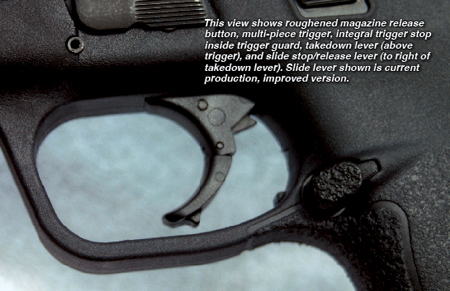 As diligently as S&W has pursued the ideal of perfect function with their new pistol, it has still eluded the M&P design in some small ways. The wavy, sharp-edged grasping grooves on the slide made operation quick and positive when the gun is in hand. However, at least one user found that when the gun was carried in deep concealment in a belly band next to bare skin, the sharp edges of the slide cuts abraded him unmercifully. He told this writer that two hours into a day shift, he called home to his wife to bring him a Glock in the same caliber at work.
As diligently as S&W has pursued the ideal of perfect function with their new pistol, it has still eluded the M&P design in some small ways. The wavy, sharp-edged grasping grooves on the slide made operation quick and positive when the gun is in hand. However, at least one user found that when the gun was carried in deep concealment in a belly band next to bare skin, the sharp edges of the slide cuts abraded him unmercifully. He told this writer that two hours into a day shift, he called home to his wife to bring him a Glock in the same caliber at work.
The M&P is clearly chasing the Glock pistol, and one of the Glock’s strongest points in the field has proven to be the virtual invulnerability of its TeniferTM finish. Tenifer cannot be applied to pistols in the United States, and the S&W M&P is a “made in USA” product. Therefore, S&W finishes it with MeloniteTM, which has been called an American analog to Tenifer.
This claim has not yet been definitively established. I know one purchaser of a .40 M&P who wore his new Smith next to his bare skin in an inside the waistband holster that did not shield the rear of the slide from body contact, and in one day of hot Southern summer produced rust in the slide grooves.
Summary
The Smith & Wesson Military & Police semiautomatic pistol is a very young gun, but the maturity and functionality of its design has been greatly hastened by a company policy of closely monitoring field reports and immediately acting upon any genuine shortcoming in design or execution. This is an extremely positive sign from the manufacturer. It bodes well for this particular new product, and for future offerings from Smith & Wesson.

Next Step: Get your FREE Printable Target Pack
Enhance your shooting precision with our 62 MOA Targets, perfect for rifles and handguns. Crafted in collaboration with Storm Tactical for accuracy and versatility.
Subscribe to the Gun Digest email newsletter and get your downloadable target pack sent straight to your inbox. Stay updated with the latest firearms info in the industry.








